Abstract
Intelligent compaction (IC) is an innovative and modified technology used for quality control in subgrade digital construction. However, current intelligent compaction measurement values (ICMVs) cannot provide accurate measurement of the filling layer when the strength of the underlying layer is relatively high. Experimental field tests conducted in the cut to fill subgrade were performed to collect and analyze the variability of ICMV called the vibration modulus (Evib). Furthermore, a new ICMV called the modulus of vibration compaction (Evc) that could remove the interference of the underlying layer and reveal the actual compaction state of filling layer is presented based on the theoretical analysis and numerical simulation method. It was also extracted to study the variability of the filling layer’s compaction state. The results of the above research indicate the influence of the underlying layer’s stiffness on overall compaction quality is remarkable. It was found that it is more likely to achieve the variability control of the compaction state of the filling layer by a new ICMV called Evc. The measured data, improved approaches, and associated conclusions that are presented provide valuable information for researchers and employees considering the use of IC technology.
1. Introduction
Continuous compaction control (CCC) technology has a promising application prospect into quality control practices of subgrade digital construction projects in Europe and the United States [1]. Successful quality control of subgrade soil guarantees the long-term performance of pavements. However, infiltration and non-uniform settlement easily occur in a subgrade with insufficient strength, which is an important cause of early pavement failure, such as cracking and subsidence [2]. Thus, CCC can achieve the sufficient strength and stability of the subgrade and then extend the service life of pavements. There are several drawbacks in the manual measurements of the existing compaction assessment (ring knife method, sand filling method, settlement control method) can be summarized into two aspects: (1) the testing results acquired from limited points cannot find weak areas of local compaction, and (2) the above measurements are time-consuming, and it is impossible to obtain the variation law of real-time compaction information [3].
Due to many defects of manual measurements, a new continuous compaction control technology named intelligent compaction (IC) has been gradually developed to solve the problems [4]. In the 1970s, Thurner and Sandström put forward the concept of continuous compaction control and then analyzed the vibration characteristics of a vibration roller so as to achieve comprehensive detection of subgrade compaction quality [5,6,7,8]. After 40 years of rapid development of continuous compaction control technology, many compaction control indicators were developed based on different principles [9,10,11]. Because the influence depth of the vibratory roller is high, the index value of compaction control actually reflects the overall compaction quality of the subgrade within the range of the influence depth. However, the strength of the underlying layer is very high in special conditions such as the excavation area at the junction of filling and excavation. Meanwhile, the control indexes of continuous compaction become larger because of the strength influence of the underlying layer, and it is difficult to reflect the actual compaction quality of the current filling layer [12]. Actually, the vibration modulus Evib is a mechanical index derived from the principles of dynamics and material mechanics. Theoretically, it is unreasonable to establish the correlation between Evib and compactness of the physical index with the influence of the high-strength underlying layer [13,14]. In addition, the influence of the underlying layer’s strength and filling height on the change of control indexes is not clear.
However, the regression correlations between ICMVs are complicated as the correlations are not only affected by roller parameters but also by subgrade parameters [15,16,17]. In terms of soil properties, it mainly involves the moisture content and underlying stiffness [18]. In addition, investigating the influence of above factors on the correlation between ICMVs will contribute to the further development of IC technology. In fact, ICMVs can reduce laborious efforts and enable real-time control of subgrade quality.
In addition, the dynamic solution of steel wheels and subgrade models has become simple because of the development of computer simulation technology, and related software can independently determine whether the steel wheel has bouncing behavior [19]. In terms of model refinement, considering the overall performance of the mechanical cab, wheel frames, and other components, and the impact of results is analyzed instead of a single rigid cylindrical roller for calculation [20,21,22]. Therefore, it takes into account the harmonic phenomenon was caused by an increase in stiffness in the calculation of ICMVs [23,24,25]. High-order harmonics can interfere with the detection results, and the actual improvement effect of detection accuracy may not be very ideal [26,27,28]. For materials with negligible plasticity indicators, such as fly ash, it can effectively improve the detection performance of ICMVs for fillers with larger particle sizes [29,30,31,32].
Therefore, in this paper, I design relevant experiments based on the principle of continuous compaction control in the site construction. And then, we analyze the variation law of compaction quality of subgrade about the strength of underlying layer and the thickness of the filling layer on the control index of continuous compaction. Finally, based on the above research efforts [33,34,35], a new continuous compaction control index, modulus of vibration compaction Evc, is proposed to remove the influence of the underlying layer, so as to improve the variability of the filling layer.
2. Objective and Scope
This study focused on the quality of subgrade compaction and variability control principle of the vibration modulus. To fulfill this purpose, experimental field tests were performed to analyze the vibration behavior of compaction indexes and vibration modulus Evib. For vibratory rollers, it is presented based on a semi-analytical modelling of the elastic double-deck subgrade. Compaction quality, thickness of filling layer, and strength of underlying layer were collected, calculated, and analyzed. This study was designed to develop the database of Evc and control the variability of ICMV in the cut to fill subgrade.
3. Methodology
3.1. Field Test of Continuous Compaction Control
The test field was constructed in Zhejiang, China. Figure 1a shows the distribution of test points. The test field area is 600 m2 (150 m × 4 m), divided into two rectangular test zones with a width of about 2 m. There are 15 measure points which is 5 m apart on each side. A signpost is used on one side of the test strip to determine the test location.
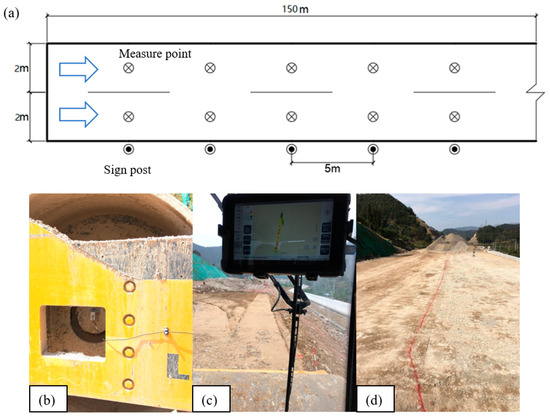
Figure 1.
Layout of test field: (a) test zone; (b) installation position of acceleration sensor; (c) Compaction Information System (CIS) display at the operator station; (d) boundary line of cut to fill in the completion of roller compaction.
The construction type is soil–rock mixed subgrade with high-fill that is located in the cut to fill sections in the test field. As shown in Figure 1b, the acceleration sensor was fixed to a roller wheel to survey the vibration response to the subgrade. Prior to the compaction operation, a plan file that delineates the pavement edges can be loaded to the Compaction Information System (CIS) in order to be overlaid with the color-coded map [15]. It is shown in Figure 1c that the quality of subgrade compaction depends on the shade of the color. Figure 1d shows the compaction effect of cut to fill subgrade after completing one layer of subgrade compaction; the red line represents the boundary line of cut to fill subgrade. According to Test methods of soils for highway engineering [29], the soil is tested to determine basic physical parameters, including liquid–plastic limit, plastic index, optimum moisture content, maximum dry density, etc. Table 1 presents the test results [16].

Table 1.
Physical parameters of subgrade soil.
Vibration compaction is a process of interaction between material and compacting machinery. The roller response measurement value is called Evib, which is related to the stiffness of compacted materials [17,18]. Thus, vibration parameters of compacting machinery have a significant impact on the compacting effect. The single smooth drum vibratory roller (Liu Gong CLG1622E) was used in the field test. The roller’s main technical parameters are shown in Table 2.

Table 2.
Summary of the roller.
For the research contents, five experimental conditions are set up in the test field to analyze the influence of compaction effect on different thickness of the filling layer (③④⑤) and strength of the underlying layer (①②③). Table 3 presents the parameters of 5 conditions.

Table 3.
Compaction parameters of test strips.
3.2. Numerical Simulation of Modulus of Vibration Compaction Evc
Because the action depth of the vibration wheel is greater than the thickness of the filling layer, vibration feedback to the vibration wheel actually reflects the overall compaction quality in a certain range below the roller surface, as shown in Figure 2a. The continuous compaction control index obtained is a function of the modulus and thickness of each filling layer, and Evib is calculated as Equation (1).
where Ei = modulus of filling layer; hi = thickness of filling layer.
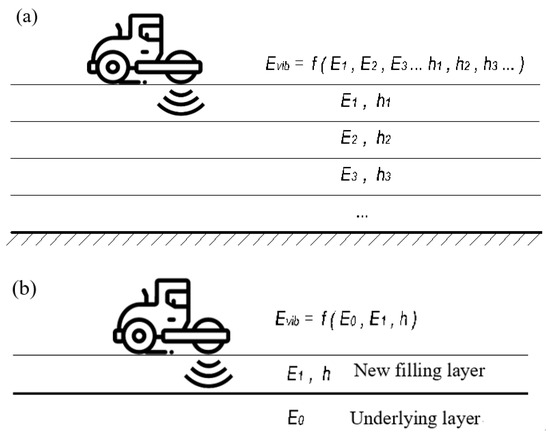
Figure 2.
Information composition of continuous compaction control index: (a) normal condition; (b) larger strength in underlying layer.
However, for some special conditions (cut to fill subgrade), the strength of the underlying layer is higher, and the vibration response to the upper layer is greater. In addition, the upper layer is relatively weak, and then, more vibration feedback is provided by the underlying layer, as shown in Figure 2b. The existence of a high-strength underlying layer makes the monitoring value of the continuous compaction control index too large to reflect the actual compaction state of the current filling layer.
In view of the above defects, this paper establishes an elastic multi-layer model of subgrade, and proposes a new continuous compaction control index, modulus of vibration compaction Evc, which is suitable for controlling the actual compaction quality of the filling layer on special conditions such as when the strength of the underlying layer is high or there is an uneven distribution.
3.2.1. Computing Principle of Evc
In order to make indexes accurate and scientific, some assumptions are as follows: (1) the subgrade is composed of homogeneous and isotropic linear elastic materials; (2) the subgrade structure is a semi-infinite body which extends infinitely in horizontal direction and infinitely downward in the Z direction, and the stress and displacement in infinite depth are zero.
The above assumptions regard the subgrade as an elastic semi-infinite space body. When a vertical concentrated force Q acts on the surface of subgrade, the deflection of any point in the semi-infinite body can be obtained by Bussinick’s solution, as shown in Figure 3a. In the rectangular coordinate system, the vertical deformation of any point can be calculated as Equations (2) and (3) [17,29].
where = vertical deformation at calculation points (m); = Poisson’s ratio of material; E = modulus of material (Pa); R = distance between action point and calculation point (m); and x,y,z = coordinates of calculation points.

Figure 3.
Schematic diagram of computing principle: (a) Businisk solution; (b) load distribution on top of the subgrade under the action of a rigid roller wheel.
When calculating the top deflection of the subgrade, the vertical coordinate z is zero, which is placed into Equations (2) and (3), and can be determined as in [24].
where s = top deflection of subgrade (m); r = horizontal distance between action point and calculation point (m).
When the roller acts on the subgrade, it can be regarded as an absolutely rigid object (EI→∞) because of its great stiffness and there would be no deflection, and the deflection of each point on the top surface of subgrade is the same as width of the steel wheel. According to elastic theory, the load distribution on the top surface of the subgrade is saddle-shaped, with a small center and large edge, as shown in Figure 3b. When calculating the deflection of the top surface of the subgrade, the element area can be taken in the contact range, and the distributed load acting on the element area can be expressed by the concentrated load . At this time, the deflection of the subgrade surface point can be obtained by [27].
3.2.2. Development of 3D FE Models and Database
A three dimensional (3D) finite-element (FE) model of an elastic double-deck subgrade was established using the ABAQUS program, as shown in Figure 4a. In the horizontal direction, the size of double-deck subgrade structure is 20 m × 10 m. In the vertical direction, the depth of the underlying layer is 6 m, and the filling layer is 0.31 m. The aggregates and soil particles are in contact with each other, and then, the friction between layers was larger [19]. Thus, the filling layer and underlying layer were gradually compacted because of their good bonding performance. The model was meshed with eight-node solid brick elements. The size of the filling layer’s elements was 10 cm, whereas it was 50 cm for the underlying layer.
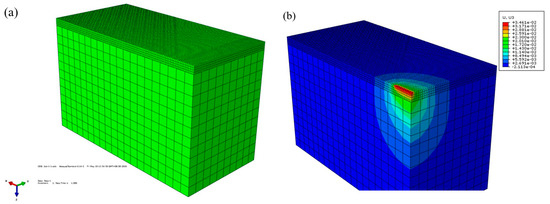
Figure 4.
The 3D FE model established with the ABAQUS program: (a) mesh generation of elastic double-deck subgrade; (b) simulation results of deformation.
The deflection database was established by numerical simulation of models, and Evib of the filling layer and underlying layer is chosen to range from 9.5 MPa to 10.8 MPa with a variable step of 0.1 MPa. Considering that both the model and the concentrated load are axisymmetrically distributed, only one fourth of the models were analyzed and simulated. All combinations of Evib in the variation are simulated to calculate the deflection of the top surface of the subgrade at the load center. A total of 196 modulus combinations are simulated and calculated. The single simulation results are shown in Figure 4b.
Evc is output by the corresponding deflection obtained with Evib of the top surface and Evib of the underlying layer. The database was established with simulation results, which are interpolated linearly with a step size of 0.01 MPa of Evib. Finally, the number of deflection values for combinations of the underlying layer and filling layer with Evib varying from 9.5 MPa to 10.8 MPa is 17,424.
4. Results and Discussion
4.1. Variation Laws of Overall Compaction Quality of Subgrade
In this section, Evib is used as the index to analyze the variation laws of different thickness of the filling layer and different strength of the underlying layer on the overall compaction quality of the subgrade.
4.1.1. Thickness of Filling Layer
Experimental data of three conditions (③④⑤ in Table 3) are analyzed to develop the influence of thickness of the filling layer on the overall compaction quality of the subgrade in Figure 5. Figure 5a shows that the distribution curve of the final compaction value with different thickness of filling layer has an obvious stratification phenomenon at the same roller passes. When the thickness of the filling layer is increasing, the final compaction value Evib decreases gradually, which indicates that the overall compaction quality of the subgrade decreases with the increasing thickness of the filling layer.
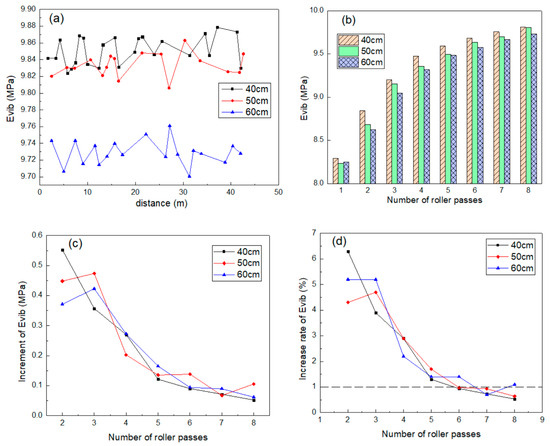
Figure 5.
Influence law of thickness of filling layer on subgrade compaction quality: (a) final compaction value Evib; (b) mean value Evib with number of roller passes; (c) increment of mean value Evib with number of roller passes; (d) growth rate of Evib with number of roller passes.
It was found that the difference of Evib between thicknesses of 40 cm and 50 cm is very small. However, the final compaction value in thickness of 60 cm is much lower than that in thicknesses of 40 cm and 50 cm. Two possible reasons can be explained for the phenomenon. One reason is that the subgrade with a thinner filling layer has reached a higher strength before the 8th roller pass. Interestingly, it is not obvious to improve the strength of the filling layer. However, the strength of the subgrade with a slightly thicker filling layer increases relatively with more roller passes. Another reason is related to the effective compaction depth of the vibratory roller. It was provided that the compaction effect of a 20-ton vibratory roller on the filling thickness of 40 cm is the best, but the compaction effect of it on the filling thickness of 60 cm is poor [20]. Other research shows that the dynamic pressure produced by the vibratory roller decreases sharply at the depth of 40–60 cm [21]. When the filling layer is thicker, it is difficult to transmit the dynamic pressure produced by the vibratory roller to the lower part of the filling layer, which makes the lower part difficult to be compacted, and then, it affects the compaction effect of the upper filling layer.
Figure 5b,c show that the compaction quality of the subgrade decreases at any stage of rolling with increases in the thickness of the filling layer. The lines shown on these figures are presented to show that the difference in Evib between 40 cm thickness of the filling layer and 50 cm thickness of the filling layer gradually narrows in the last three roller passes. The strength growth of the subgrade is slowed down because the overall strength of the subgrade has been already high in the case of the 40 cm filling layer. Comparatively, it is too thick for the 60 cm filling layer to be fully compacted, and then the subgrade strength is still increasing slowly after each roller. This variation law is consistent with the deduction of this phenomenon based on the depth of the compaction effect.
As shown in Figure 5d, it can be referred that increasing the subgrade strength mostly concentrates on the first four roller passes, and then, it increases slightly on the last four roller passes. According to the suggestion in Technical Conditions of Intelligent Compaction Control System for Highway Subgrade Filling Engineering [19], it can be determined that the strength reaches a stable state, in which the compaction quality will not be changed significantly again as the increased rate of Evib of two adjacent rollers does not exceed 1%.
4.1.2. Strength of Underlying Layer
Experimental data of three conditions (①②③ in Table 3) are analyzed to develop the influence of strength of the underlying layer on the overall compaction quality of the subgrade in Figure 6. As shown in Figure 6a, the distribution curve of the final compaction value with different strength of the underlying layer has obvious stratification phenomenon on the same roller passes. When the strength of the underlying layer i increases, the final compaction value Evib increases gradually, which indicates that the overall compaction quality of the subgrade improves with the increasing of strength of the underlying layer.
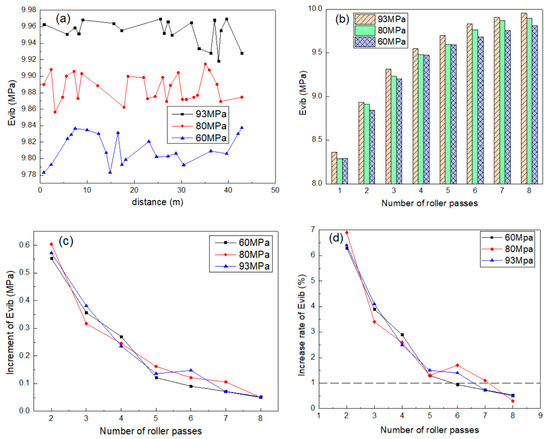
Figure 6.
Influence law of strength of underlying layer on subgrade compaction quality: (a) final compaction value Evib; (b) mean value Evib with number of roller passes; (c) increment of mean value Evib with number of roller passes; (d) growth rate of Evib with number of roller passes.
Results in Figure 6b,c indicate the compaction quality of the subgrade decreases at any stage of rolling with a reduction in the strength of the underlying layer. Figure 6d shows the variation law of the increase rate of Evib with the number of roller passes, and the variable trend is the same as that of different thicknesses of the filling layer. It can be found that the compaction quality of only the 60 MPa underlying layer is stable at six passes, and the compaction quality of three experimental conditions reach a stable state at eight passes. One possible reason is that the high-strength underlying layer provides powerful support for the compacted soil, so that the soil can continue to be compacted under the action of external forces.
4.1.3. Variability of Evib
The variation law of variability in Evib on the subgrade top surface with roller passes under different filling height and the underlying layer’s strength is analyzed by above results of field tests.
According to the recommendation of Technical Conditions for Continuous Compaction Control System of Highway Subgrade Filling Project [13], the uniformity of compaction can be controlled by the variability in the test data. The formula of the control conditions is as follows.
The coefficient η is 0.8; that is, if the continuous compaction control index value of each point is greater than 80% of the detection target value, it is considered that the current roller uniformity meets the requirements. Figure 7 shows that the influence of different working conditions on the compaction variability is obvious. At the beginning of rolling, the compaction variability of each working condition is higher and ranges from 32.5% to 42.5%. It was noted that the degree of irregularity in the condition of 40 cm thickness and 93 MPa strength decreases rapidly with roller passes, and the value becomes zero at five passes that means that the variability meets the requirement. Then, the condition of 40 cm thickness and 80 MPa strength has the same variation law, but it meets the variability requirement at six passes. Another three conditions of the data analysis are similar to the above two condition results. It was also found that with seven passes for the condition of 40 cm thickness and 60 MPa strength, 50 cm thickness and 60 MPa strength, and eight passes for 60 cm thickness and 60 MPa strength that the compaction variability reaches the standard. In view of compaction variability control, it was proven that increasing the strength of the underlying layer and reducing the thickness of the filling layer are beneficial to achieving a higher quality of the compaction state.
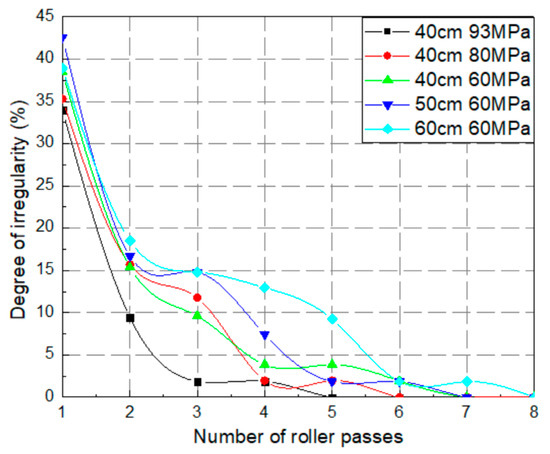
Figure 7.
Variation in degree of irregularity of compaction with roller passes under different working conditions.
4.2. Comparsion of Evc in Filling Layer and Evib
For the filling section with a high-strength underlying layer, the underlying layer will affect the value of the continuous compaction control index on the quality of the current roller layer, which will lead to a higher value of measurement results. In order to eliminate this influence, Evc of each filling layer in the test field was calculated with simulation results of the database, and the variation law of the compaction space variability at the filling-excavation junction is analyzed from two aspects of the overall vibration modulus (Evib) and the vibration modulus of the filling layer (Evc).
Figure 8a,b show that the difference in Evib in two test strips is evident from the first layer to the fourth layer, and it has no obvious difference after four layers (0~2 m of horizontal direction is the test zone for the 60 MPa underlying layer, and 2~4 m of horizontal direction is the test zone for the 80 MPa underlying layer). However, the difference in Evc in two test strips is not obvious in the first four layers. It can be inferred that the roller variability at the filling–excavation junction actually comes from the underlying layer rather than the roller layer.
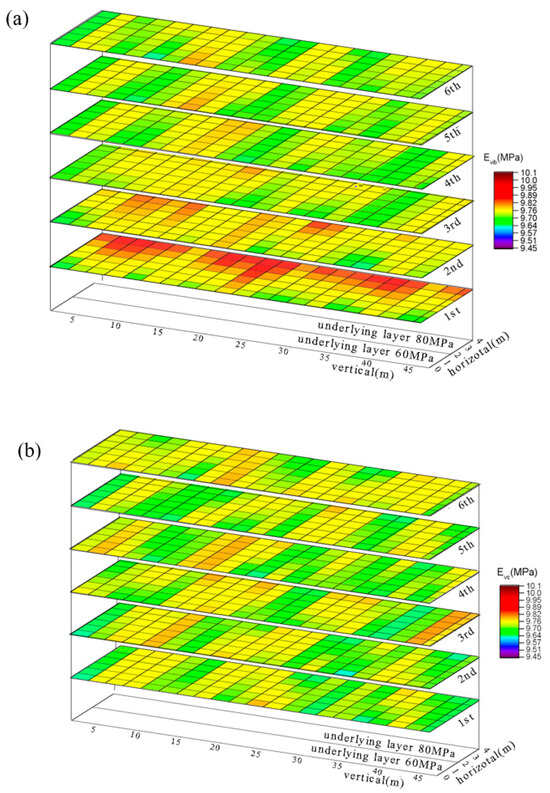
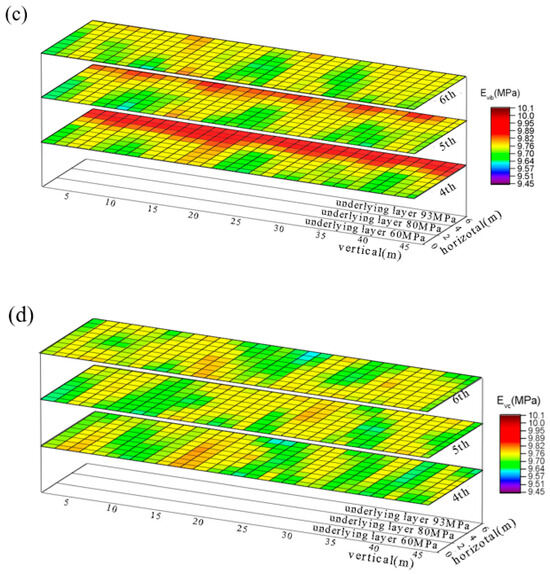
Figure 8.
A 3D distribution map of compaction effect: (a) variation in Evib with the strength of underlying layer is 60 MPa, 80 MPa; (b) variation in Evc when the strength of underlying layer is 60 MPa, 80 MPa; (c) variation in Evib when the strength of underlying layer is 60 MPa, 80 MPa, 93 MPa; (d) variation in Evc when the strength of underlying layer is 60 MPa, 80 MPa, 93 MPa.
Figure 8c,d present the variation law of Evib and Evc, respectively, in three test strips (4~6 m of the horizontal direction is the test zone for the 93 MPa underlying layer) from the fouth layer to the sixth layer. Evib of the test zone with the 93 MPa underlying layer is much higher than that of the other two test zones, but Evc of the roller compaction layer with the 93 MPa underlying layer is not different so much from the other two test zones. Moreover, the difference in Evib between the test zone with 93 MPa and the other two test zones gradually decreases with the filling proceeds, which indicates that the influence of the high-strength underlying layer gradually weakens with the increasing number of filling layers. Comparatively, Evc of the filling layer is stable at the same level as that of the other two test zones from the beginning to the end.
5. Conclusions
This paper describes the results from a research study that was conducted to compare the vibration modulus Evib and the newly proposed index Evc with location-specific in situ test results. The main findings gained from the above work are summarized as follows.
- Intelligent compaction was based on a theoretical concept and field experiment that the real-time vibration response to the subgrade was manifested in compaction indexes. Application of these indexes was able to capture the difference of the subgrade stiffness and use it to estimate the compaction quality.
- In this paper, a detailed method is given to utilize Evc as a real-time index to control the variability of the compaction modulus in the condition which the strength of the underlying layer is large or uneven. The procedure of establishing the database and simulation results based on the elastic double-deck subgrade are also presented.
- A field experiment was conducted on this test strip to analyze the influence law of different thicknesses of the filling layer and the strength of the underlying layer on the subgrade modulus Evib. It can be concluded that the correlation of thickness with the overall compaction quality is negative, and the correlation of strength with that is positive. Furthermore, the over-high strength underlying layer will affect the monitoring value of the traditional continuous compaction control index, so that the measured value is greater than the actual strength of the current roller layer.
- Simulation results of the corresponding Evc were acquired by specific targets of the database. It was concluded that the variability in Evib of the subgrade decreases gradually with an increasing number of filling layers, and the variability in Evc of the filling layer remains at a lower level.
- The modulus variability in the cut to fill subgrade mainly comes from the strength difference in the underlying layer, not the thickness difference in the filling layer. It was suggested that the modulus variability in the filling layer may increase with supplementary roller compaction, only considering the variability in Evib of the subgrade.
- A critical aspect of this proposed index Evc is that it is able to improve the quality control of the subgrade stiffness. It was demonstrated through filed tests that Evib can be used to monitor the overall compaction quality in real time, and Evc was extracted to identify the compaction quality of the filling layer.
While the results presented herein are promising, it is necessary to point out that the tests so far have focused on the cut to fill subgrade. As the effects of strength and the filling thickness are considered separately, further tests can be designed to explore the effects of them superimposed on each other. Finally, it should be noted that IC does not provide a direct measurement of Evc, rather it provides an indirect Evc value. Thus, further discussion and research are necessary to address this issue in future studies.
Author Contributions
The authors confirm contributions to the paper as follows: Conceptualization, Z.W.; Data curation, Z.W.; Formal analysis, Z.W.; Writing—original draft, Z.W.; Writing—review & editing, J.Q. & J.L. All authors have read and agreed to the published version of the manuscript.
Funding
This research received no external funding.
Data Availability Statement
The data presented in this study are available on request from the corresponding author. The data are not publicly available due to privacy.
Acknowledgments
This study described in this paper is supported by the Fundamental Funds of Zhejiang Province, China. The authors acknowledge Yiming Xie for their assistance during the testing. Many members of the Jianming Ling Group at Tongji University assisted with field testing on this project. Their assistance and efforts are greatly appreciated.
Conflicts of Interest
The authors declare no conflict of interest.
References
- Mooney, M.A.; Adam, D. Vibratory Roller Integrated Measurement of Earthwork Compaction: An Overview. In Proceedings of the FMGM2007-Intelligent Symposium on Field Measurements in Geomechanics, Boston, MA, USA, 24–27 September 2007. [Google Scholar]
- Fhwa. FHWA/TPF Research Project Accelerated Implementation of Intelligent Compaction Technology for Embankment Subgrade Soils, Aggregate Base, and Asphalt Pavement Materials.U.S.; Federal Highway Administration: Washington, DC, USA, 2011.
- Zhu, X.; Bai, S.; Xue, G.; Yang, J.; Cai, Y.; Hu, W.; Jia, X.; Huang, B. Assessment of compaction quality of multi-layer pavement structure based on intelligent compaction technology. Constr. Build. Mater. 2018, 161, 316–329. [Google Scholar] [CrossRef]
- Thurner, H.; Forsblad, L. Compaction Meter on Vibrating Rollers; Transportation Research Board: Washington, DC, USA, 1978. [Google Scholar]
- Richart, F.E.; Hall, J.R.; Woods, R.D. Vibrations of Soils and Foundations; Prentice Hall: Englewood Cliffs, NJ, USA, 1970. [Google Scholar]
- Thurner, H.; Forssblad, L. The Compaction Meter—A Modern Method for the Surveillance and Control of Compaction. Rev. Gen. Routes Aerodr. 1979, 36, 67–71. [Google Scholar]
- White, D.; Thompson, M.; Vennapusa, P.; Siekmeier, J. Implementing intelligent compaction specification on Minnesota TH-64: Synopsis of measurement values, data management, and geostatistical analysis. Transp. Res. Rec. J. Transp. Res. Board 2008, 2045, 1–9. [Google Scholar] [CrossRef]
- Roller-Integrated Continuous Compaction Control (CCC): Technical Contractual Provisions, Recommendations; ISSMGE: London, UK, 2005.
- Vennapusa, P.R.; White, D.J.; Morris, M.D. Geostatistical analysis or spatially referenced roller-Integrated Compaction Measurements. J. Geotech. Geoenviron. Eng. 2009, 136, 813–822. [Google Scholar] [CrossRef]
- White, D.J.; Vennapusa, P.; Gieselman, H.; Zhang, J.; Eidem, M. Accelerated Implementation of Intelligent Compaction Technology for Embankment Subgrade Soils, Aggregate Base, and Asphalt Pavement Materials: US 12 Marmarth, North Dakota; Final Report ER10-08 US12, ND Field Project; Iowa State University: Ames, IA, USA, 2010. [Google Scholar]
- Pistrol, J.; Villwock, S.; Völkel, W.; Kopf, F.; Adam, D. Continuous Compaction Control (CCC) with Oscillating Rollers. Procedia Eng. 2016, 143, 514–521. [Google Scholar] [CrossRef]
- Li, J. Evaluation of Intelligent Compaction Control in the M-189 Reconstruction Project at Iron River, Michigan. Master’s Thesis, Michigan Technological University, Houghton, MI, USA, 2013. [Google Scholar]
- Aouad, M.F.; Stokoe, K.H., II; Briggs, R.C. Stiffness of Asphalt Concrete Surface Layers from Stress Wave Measurements; Transportation Research Record 1384: Washington, DC, USA, 1993; pp. 29–35. [Google Scholar]
- Von Quintus, H.L.; Rao, C.; Minchin, R.E.; Nazarian, S.; Maser, K.R.; Prowell, B.D. NDT Technology for Quality Assurance of HMA Pavement Construction; NCHRP Report No. 626; Transportation Research Board: Washington, DC, USA, 2009; 133p. [Google Scholar]
- Meehan, C.L.; Cacciola, D.V.; Tehrani, F.S.; Baker, W.J., III. Assessing Soil Compaction using Continuous Compaction Control and Location-Specific In Situ Tests. Autom. Constr. 2017, 73, 31–44. [Google Scholar] [CrossRef]
- Hu, W.; Shu, X.; Huang, B.; Woods, M.E. An Examination of Compaction Meter Value for Asphalt Pavement Compaction Evaluation. Int. J. Pavement Eng. 2018, 19, 447–455. [Google Scholar] [CrossRef]
- Ling, J.; Lin, S.; Qian, J.; Zhang, J.; Han, B.; Liu, M. Continuous Compaction Control Technology for Granite Residual Subgrade Compaction. J. Mater. Civ. Eng. 2018, 30, 04018316.1–04018316.9. [Google Scholar] [CrossRef]
- Zhang, D.; Jiang, H.; Gao, M.; Zhang, J.; Xiang, W.; Yan, X.; Guo, D.; Zhao, C.; Wu, L. Quality Acceptance Methods and Standards for Continuous Compaction Control Technology. Int. J. Transp. Eng. Technol. 2019, 5, 82–87. [Google Scholar]
- Tao, M.; Zhou, F. Simulation analysis of dynamic response of subgrade vibration compaction. Chin. J. Highw. 2022, 5, 1–11. [Google Scholar]
- Xu, Q.W.; Chang, G.K.; Gallivan, V.L.; Horan, R.D. Influences of intelligent compaction uniformity on pavement performances of hot mix asphalt. Constr. Build. Mater. 2012, 30, 746–752. [Google Scholar] [CrossRef]
- Ma, Y.; Luan, Y.C.; Zhang, W.G.; Zhang, Y.Q. Numerical simulation of intelligent compaction for subgrade construction. J. Cent. South Univ. 2020, 27, 2173–2184. [Google Scholar] [CrossRef]
- Carrasco, C.; Tirado, C.; Wang, H. Collaborative Proposal: Numerical Simulation of Intelligent Compaction Technology for Construction Quality Control; Report of CAIT-UTC-029; Texas Department of Transportation: Austin, TX, USA, 2014.
- Yang, C.W.; Zhang, L.; Han, Y.; Cai, D.; Wei, S. Study on the transmission and evolution characteristics of vibration wave from vibratory roller to filling materials based on the field test. Appl. Sci. 2020, 10, 2008. [Google Scholar] [CrossRef]
- Facas, N.W.; Susante, P.J.; Mooney, M.A. Influence of rocking motion on vibratory roller-based measurement of soil stiffness. J. Eng. Mech. 2010, 136, 898–905. [Google Scholar] [CrossRef]
- Susante, P.J.; Mooney, M.A. Capturing nonlinear vibratory roller compactor behavior through lumped parameter modeling. J. Eng. Mech. 2008, 134, 684–693. [Google Scholar] [CrossRef]
- Liu, D.H.; Li, Z.L.; Liu, J.L. Experimental study on real-time control of roller compacted concrete dam compaction quality using unit compaction energy indices. Constr. Build. Mater. 2015, 96, 567–575. [Google Scholar] [CrossRef]
- White, D.J.; Vennapusa, P.; Tutumluer, E.; Vavrik, W.; Moaveni, M.; Gillen, S. Spatial verification of modulus for pavement foundation system. Transp. Res. Rec. J. Transp. Res. Board 2018, 2672, 333–346. [Google Scholar] [CrossRef]
- Vennapusa, P.K.R.; White, D.J.; Gieselman, H. Influence of Support Conditions on Roller-Integrated Machine Drive Power Measurements for Granular Base. In Contemporary Topics in Ground Modification, Problem Soils, and Geo-Support; ASCE Library: Orlando, FL, USA, 2009; pp. 425–432. [Google Scholar]
- Du, W.Y.; Song, W.P.; Feng, D.C.; Zhang, L.H. Study on GPS Ranging Technology for Intelligent Detection of Subgrade Compaction. Appl. Mech. Mater. 2012, 220–223, 1533–1538. [Google Scholar] [CrossRef]
- Academy of Highway Science, Ministry of Communications of the People’s Republic of China. Regulations for Highway Geotechnical Testing (JTG E40-2007); People’s Transportation Press: Beijing, China, 2010. [Google Scholar]
- Von Quintus, H.L. Evaluation of Intelligent Compaction Technology for Densification of Roadway Subgrades and Structural Layers; Pavement Layers; Applied Research Associates Inc.: Albuquerque, NM, USA, 2010. [Google Scholar]
- Barman, M.; Nazari, M.; Imran, S.A.; Commuri, S.; Zaman, M.; Beainy, F.; Singh, D. Quality control of subgrade soil using intelligent compaction. Innov. Infrastruct. Solut. 2016, 1, 23. [Google Scholar] [CrossRef]
- Hu, F.; Xu, C.; Li, H.; Li, S.; Yu, Z.; Li, Y.; He, X. Particles interaction forces and their effects on soil aggregates breakdown. Soil Tillage Res. 2015, 147, 1–9. [Google Scholar] [CrossRef]
- Hongzhu, K.; Bingzhang, N.; Li, Z. Study on compaction of high liquid limit clay by vibratory roller with large excitation force. Road Constr. Mach. Constr. Mech. 2014, 31, 45–49. [Google Scholar]
- Cheng, W. Construction Technology of Earth-Rock Mixed Filling Subgrade. Shanxi Archit. 2011, 37, 138–139. [Google Scholar]
Disclaimer/Publisher’s Note: The statements, opinions and data contained in all publications are solely those of the individual author(s) and contributor(s) and not of MDPI and/or the editor(s). MDPI and/or the editor(s) disclaim responsibility for any injury to people or property resulting from any ideas, methods, instructions or products referred to in the content. |
© 2023 by the authors. Licensee MDPI, Basel, Switzerland. This article is an open access article distributed under the terms and conditions of the Creative Commons Attribution (CC BY) license (https://creativecommons.org/licenses/by/4.0/).